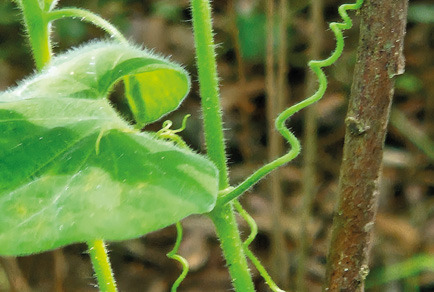Abstract
This study provides a comprehensive morphological description and updated information of Sicydium nereoi, a microendemic climbing species of Cucurbitaceae, rediscovered in the riparian islands of Esquina, Corrientes, Argentina, after 50 years of being known only from the type specimen. We document for the first time the morphology of the pistillate flowers, fruits, and seeds, which differ from other Sicydium species by their ovoid, fleshy fruits, densely pubescent ovary, and glandular trichomes. A total of thirty-four individuals were recorded in three populations, restricted to an area of occupancy of 8 km² on organic-rich, calcareous soils. Based on IUCN criteria, we assign S. nereoi to the Critically Endangered (CR) category due to its limited distribution, small population size, and threats from habitat degradation and land use change. These findings provide key insights into the species’ morphological distinctiveness, ecological niche, and urgent conservation needs.
References
- Baillon, H. (1864) Species Euphorbiacearum. Euphorbiacees Americaines, Premiere partie: Ameriqueaustro-orientale. Adansonia 4: 257–377.
- Bentham, G. & Hooker, J.D. (1884) Compositae: Zexmenia- Aspilia. In: Martius, C.F.P. von (Ed.) Flora Brasiliensis, Vol. 6, Part 3. F. Fleischer, Monachii & Lipsiae, pp. 188–197.
- Cabrera, A.L. (1949) El nombre correcto de la Lucera. Boletín de la Sociedad Argentina de Botánica 3 (1): 35–36.
- Cavanilles, A.J. (1795) Icones et descripciones plantarum, vol. III. Ex Regia Typographia, Madrid, pp. 47–48.
- Cogniaux, A. (1878) Cucurbitaceae. In: Martius, C.F.P. (Ed.) Flora Brasiliensis VI.4. F. Fleischer, Leipzig, pp. 1–126.
- Cogniaux, A. (1916) Cucurbitaceae: Fevilleae et Melothrieae. In: Engler, A. (Ed.) Das Pflanzenreich IV.275.1. Wilhelm Engelmann, Leipzig, pp. 1–277.
- Florentín, J.E., Vallejos, C., Salas, R., Medina, W.A. & Salariato, D.L. (2025) Riqueza y distribución de plantas vasculares endemicas de la provincia de Corrientes, Argentina. Bonplandia 34 (1): 1–16.
- Gómez de la Maza, M. (1896) Catálogo de las perigoniadas cubanas, espontáneas y cultivadas. Anales del Instituto de Segunda Ensenanza de La Habana 2: 277–280.
- Google Earth Pro (2018) Google Earth Pro. Available from: https://www.google.com.ar/intl/es/earth/ (accessed October 2024)
- Harms, H.A. (1897) Cyclantheropsis Harms, eine neue Curcurbitaceen-Gattung aus dem tropischen Afrika. Botanische Jahrbücher für Systematik, Pflanzengeschichte und Pflanzengeographie 23: 169–170.
- Hooker, W.J. & Arnott, G.A.W. (1833) Contributions towards a flora of South America and the Islands of the Pacific. In: Hooker, W.J. (Ed.) Botanical Miscellany. Volume 3. John Murray, London, pp. 202.
- Hooker, W.J. & Arnott, G.A.W. (1841) Contributions towards a flora of South America, and the Islands of the Pacific. Journal of Botany (Hooker) 3: 313–314.
- International Union for Conservation of Nature (IUCN) (2012) The IUCN Red List categories and criteria. Ver. 3.1. 2nd ed. IUCN.
- IUCN Standards and Petitions Committee. (2024) Guidelines for Using the IUCN Red List Categories and Criteria. Version 16. Prepared by the Standards and Petitions Committee. Available from: https://www.iucnredlist.org/documents/RedListGuidelines.pdf (accessed May 2025)
- Lamarck, J.B. (1786) Genera Conyza. Encyclopédie Méthodique, Botanique, vol. 2. Panckoucke, Paris & Liège, pp. 81–94.
- Lira, R. (1995) A New Species of Sicydium Schlchtendal (Cucurbitaceae: Zononioideae, Zanonieae, Sicydiinae) for the Flora Mesoamericana. Novon 5 (3): 284–286.
- Lira, R., Villaseñor, J.L. & Ortiz, E. (2002) A proposal for the conservation of the family Cucurbitaceae in Mexico. Biodiversity and Conservation 11: 1699–1720.
- Lira, R. (2004) El género Sicydium (Cucurbitaceae, Zanonioideae, Zanonieae, Sicydiinae) en México. Acta Botanica Mexicana 68: 39–64.
- Martius, C.F.P. von (1823) Reise in Brasilien 1: 555 pp.
- Martius, C.F.P. von (1886) Sterculiaceae. In: Martius, C.F.P., Eichler, A.W. & Urban, I. (Eds.) Flora Brasiliensis 12, (3). Fleisher, Leipzig, pp. 80–102.
- Miller, P. (1768) The Gardeners Dictionary. John & Francis Rivington, London.
- Miquel, F.A.W. (1853) Urticineae: Celtis. In: von Martius, C.F.P. (Ed.) Flora Brasiliensis, v. 4. Typographia Regia, Monachi, pp. 179–183.
- Müller Argoviensis, J. (1865) Euphorbiaceae. Vorläufige Mittheilungen aus dem fur De Candolle’s Prodromus bestimmten Manuscript über diese Familie. Linnaea 34: 1–224.
- Nicola, M.V., Donario, S. & Pozner, R. (2015) A new species of Sicydium (Cucurbitaceae) from Argentina. Phytotaxa 197 (2): 153–156. https://doi.org/10.11646/phytotaxa.197.2.8
- Peraza, G.A., Koenen, E.J., Riina, R., Hughes, C.E., Ringelberg, J.J., Fernández-Concha, G.C., Ramírez Morillo, I.M., Can Itza, L.L., Tamayo-Cen, I., Ramírez Prado, J.H., Cornejo, X., Mattapha, S. & Duno de Stefano, R. (2022) Re-establishment of the genus Pseudalbizzia (Leguminosae, Caesalpinioideae, mimosoid clade): the New World species formerly placed in Albizia. PhytoKeys 205: 371–400.
- Persoon, C.H. (1807) Synopsis plantarum, vol. 2. Craemer, Paris & Cotta, Tübingen, 316 pp.
- QGIS Development Team (2018) QGIS Geographic Information System. Open Source Geospatial Foundation Project. Available from: http://qgis.osgeo.org (accessed May 2025)
- Pozner, R. (2017) Cucurbitaceae. In: Zuloaga, F.O. & Belgrano, M.J. (Eds.) Flora Vascular de la República Argentina, vol. 17. pp. 51–111. [ISBN 978-987-45957-7-5]
- Rasband, W.S. (1997–2016) Image J. Bethesda, Maryland: US National Institutes of Health. [http://imagej.nih.gov/ij/]
- Schaefer, H. & Renner, S.S. (2011) Phylogenetic relationships in the order Cucurbitales and a new classification of the gourd family (Cucurbitaceae). Taxon 60: 122–138.
- Simpson, M.G. (2010) Plant systematics, ed.2. Academic Press, Oxford, 752 pp. https://doi.org/10.1016/B978-0-12-374380-0.50001-4
- Sprengel, C.P. (1826) Systema Vegetabilium, editio decima sexta. Sumtibus Librariae Dieterichianae, Göttingae, pp. 851.
- Systematics Association Committee for Descriptive Biological Terminology (1962) II. Terminology of simple symmetrical plane shapes (chart 1). Taxon 11: 145–156. https://doi.org/10.2307/1216718
- Thiers, B. (2024) Index herbariorum: a global directory of public herbaria and associated staff. New York Botanical Garden’s Virtual Herbarium. https://doi.org/10.3897/biss.2.26440
- Schlechtendal, D.F.L von (1832) De plantis mexicanis. Linnaea 7: 380–400.
- Weddell, H.A. (1852) Additions a la flore de L’ Amérique du sud. Annales des Sciences Naturelles Botanique, série 3 18: 197–203.
- Willdenow, C. (1799) Species plantarum, ed. 4, 2 (1). G.C. Nauk, Berolini, 823 pp.


